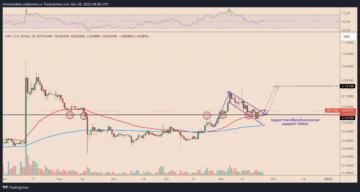In July, Bitcoin mining stocks continued their positive 2023 run, with the top 10 stocks by market cap gaining 23.10% on the month on average, with a year-to-date return of 277.34%.
In comparison, the Bitcoin (BTC) price lost 3.59% in July as it failed to build support above $30,000 for the sixth week since June. Despite a difficult July, the BTC price is still up 78.88% in 2023.

The decline in Bitcoin’s price reduced the profitability of miners. To make conditions more challenging for miners, the mining difficulty reached a new all-time high, reducing miner profitability.
Historical trends show that the network’s hash rate could continue to rise leading up to the halving on April 26, 2024 as miners increase their hashing power by installing new efficient machines.
Besides adding to their processing power, miners are also adopting other hedging techniques like selling Bitcoin futures to lock in current prices.
As the network’s hash rate is expected to increase through the year as miners reinvest in new machines and adopt other hedging techniques, miner profitability and stock valuations will continue to face pressure in the lead-up to the event.
Bitcoin hash rate projected to grow until halving
While the BTC price has increased by around 80% year-to-date, the mining difficulty has also increased by 51%, offsetting the rise in profitability from the price surge.
In mid-July, Bitcoin’s difficulty set a new all-time high of 53.91 trillion units. The increase in difficulty triggered a capitulation event in the sector, which was already reeling under pressure at the start of the month.

Bitcoin’s hashprice index, a metric used to quantify the average daily miner earnings from 1 TH/s across the industry, dropped from $78.30 per TH/s on July 1 to $72 per TH/s by the end of July, per Hashrate Index data.

The network’s hash rate deflated in the second half of July, resulting in a 2% decline in its difficulty in the adjustment on July 26.
The adjustment will likely ease the pressure on miners, but only slightly. The total hash rate is still ranging above last month’s lows after rising consistently since the start of 2023.
Moreover, historical trends suggest that miners will likely continue adding to their fleet, which could cramp profitability further.

Before the previous halving, Bitcoin’s hash rate grew consistently for a year, peaking only a month before the halving in May 2020. The current rise in the network’s hash rate is showing a similar trend.
Miners are preparing for the halving
Besides increasing hash power, the miners are adopting various strategies to prepare for the event.
These strategies involve improving the cash flow and profits of their operations by managing the existing and newly mined BTC before the halving.
In the previous cycle, Bitcoin miners had started accumulating BTC a year before the event and began unloading only after the rewards were slashed. However, with less than nine months, or three quarters, before the next halving, the trend hasn’t repeated yet. Miners have been seen sending large amounts of BTC to exchanges.
The one-hop supply of miners, which represents the coins received from mining pools, dipped toward a 2023 low in July.

Data from Bitfinex also shows that miner inflow to exchanges is part of a de-risking strategy to hedge their BTC on derivatives exchanges. For instance, selling BTC one-year futures allows miners to lock in a selling price of $30,000 for next year.
Some miners could also be selling to improve their cash balances before the halving.
Miners are selling record amounts of newly mined #Bitcoin to cover operational costs. Despite the prolonged bear market, mining firms like @Hut8Mining , @Foundry & @Brains remain confident and bullish on #BTC‘s future. Many are looking to derisk their operations by hedging in the… pic.twitter.com/xVyAmb8BTE
— Son of a Tech (@SonOfATech) July 26, 2023
According to data from TheMinerMag, public miners have liquidated nearly all of their newly mined Bitcoin in the last two months.
Meanwhile, Bitcoin mining stocks have continued their impressive positive rally from the start of the year and could be en route to another positive monthly closing in July.
Related: Buying Bitcoin is preferable to BTC mining in most circumstances — Analysis
Notably, miner stocks were fueled by reports of a $500 million investment by the United States-based investment fund Vanguard, a $7.2 trillion asset management firm. The fund added to its allocations of Riot Platforms (RIOT) and Maraton Digital Holdings (MARA) in certain indices.
The potential for further upside could be triggered by an ongoing short squeeze, as Marathon Digital Holdings, Riot Platforms and Cipher Mining are heavily shorted, with 20-25% of their float shares, according to Fintel data.
Nevertheless, the mining stocks showed the first signs of weakness in the second half of July, as most mining stocks recorded two negative weekly closings.
Given that the competition in the Bitcoin mining industry is expected to increase throughout the year, miners’ profitability and stock valuations may remain under stress leading up to the halving.
This article is for general information purposes and is not intended to be and should not be taken as legal or investment advice. The views, thoughts, and opinions expressed here are the author’s alone and do not necessarily reflect or represent the views and opinions of Cointelegraph.
This article does not contain investment advice or recommendations. Every investment and trading move involves risk, and readers should conduct their own research when making a decision.
- SEO Powered Content & PR Distribution. Get Amplified Today.
- PlatoData.Network Vertical Generative Ai. Empower Yourself. Access Here.
- PlatoAiStream. Web3 Intelligence. Knowledge Amplified. Access Here.
- PlatoESG. Automotive / EVs, Carbon, CleanTech, Energy, Environment, Solar, Waste Management. Access Here.
- BlockOffsets. Modernizing Environmental Offset Ownership. Access Here.
- Source: https://cointelegraph.com/news/bitcoin-mining-update-stocks-cool-off-miners-send-btc-to-exchanges-to-prep-for-halving
- :has
- :is
- :not
- $UP
- 000
- 1
- 10
- 2%
- 2020
- 2023
- 2024
- 23
- 26
- 30
- 7
- 91
- a
- above
- According
- across
- adding
- Adjustment
- adopt
- Adopting
- advice
- After
- All
- allows
- alone
- already
- also
- amounts
- an
- and
- Another
- April
- ARE
- around
- article
- AS
- asset
- asset management
- At
- average
- balances
- BE
- Bear
- Bear Market
- been
- before
- began
- Bitcoin
- Bitcoin Futures
- Bitcoin Miners
- Bitcoin mining
- bitcoin mining industry
- Bitfinex
- BTC
- btc mining
- btc price
- Bullish
- but
- by
- cap
- capitulation
- Cash
- cash flow
- certain
- challenging
- Chart
- cipher
- cipher mining
- circumstances
- closing
- Coin
- Coins
- Cointelegraph
- comparison
- competition
- conditions
- Conduct
- confident
- continue
- continued
- Cool
- Costs
- could
- cover
- Current
- cycle
- daily
- data
- decision
- Decline
- Derivatives
- derivatives exchanges
- Despite
- difficult
- Difficulty
- digital
- do
- does
- dropped
- Earnings
- ease
- efficient
- end
- Ether (ETH)
- Event
- Every
- Exchanges
- existing
- expected
- expressed
- Face
- Failed
- Firm
- firms
- First
- FLEET
- Float
- flow
- For
- from
- fund
- further
- future
- Futures
- gaining
- General
- Grow
- had
- Half
- Halving
- hash
- hash power
- hash rate
- hashing
- hashing power
- Hashrate
- Have
- heavily
- hedge
- hedging
- here
- High
- historical
- Holdings
- However
- HTTPS
- impressive
- improve
- improving
- in
- Increase
- increased
- increasing
- index
- Indicator
- Indices
- industry
- information
- installing
- instance
- intended
- investment
- investment fund
- involve
- involves
- IT
- ITS
- jpg
- July
- june
- large
- Last
- leading
- Legal
- less
- like
- likely
- LIQUIDATED
- looking
- lost
- Low
- Lows
- Machines
- make
- Making
- management
- managing
- many
- Mara
- Marathon
- MARATHON DIGITAL
- Marathon Digital Holdings
- Market
- Market Cap
- May..
- metric
- million
- mined
- miner
- Miners
- Mining
- mining difficulty
- Mining Industry
- Mining Pools
- Month
- monthly
- months
- more
- most
- move
- nearly
- necessarily
- negative
- New
- newly
- next
- of
- off
- on
- only
- operational
- Operations
- Opinions
- or
- Other
- own
- per
- performance
- Platforms
- plato
- Plato Data Intelligence
- PlatoData
- Pools
- positive
- potential
- power
- preferable
- Prepare
- preparing
- pressure
- previous
- price
- price chart
- price surge
- Prices
- processing
- Processing Power
- profitability
- profits
- projected
- public
- Public Miners
- purposes
- rally
- ranging
- Rate
- reached
- readers
- received
- recommendations
- record
- recorded
- Reduced
- reducing
- reflect
- reinvest
- remain
- repeated
- Reports
- represent
- represents
- research
- resulting
- return
- Rewards
- Ribbon
- Riot
- Rise
- rising
- Risk
- Route
- Run
- s
- Second
- sector
- seen
- Selling
- send
- set
- Shares
- Short
- Shorted
- should
- show
- showed
- showing
- Shows
- Signs
- similar
- since
- sixth
- son
- Source
- start
- started
- Still
- stock
- Stocks
- strategies
- stress
- suggest
- supply
- support
- surge
- taken
- tech
- techniques
- TH/s
- than
- that
- The
- The Coins
- their
- three
- Through
- throughout
- to
- top
- Top 10
- Total
- toward
- Trading
- Trend
- Trends
- triggered
- Trillion
- two
- under
- United
- units
- until
- Update
- Upside
- used
- Valuations
- Vanguard
- various
- views
- was
- weakness
- week
- weekly
- were
- when
- which
- will
- with
- year
- yet
- zephyrnet











